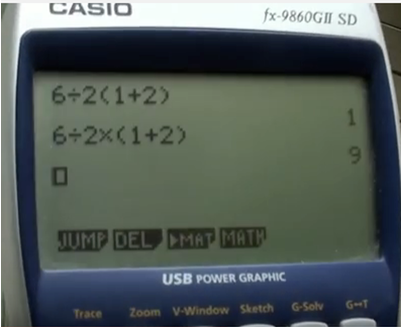8/2(2+2)=?
- This equation is not ambiguous as some people claim.
- This equation can always be solved for x with consistent results and backtested with consistent results
- Scientific Calculators[1] get the correct answer of 1(one)[2], while mis-programmed toy-shop & online calculators produce the wrong result of 16(sixteen)[2]. Hence why students must never use calculators for the entire formula and if they have to then they should ONLY use them for individual praxis within the formula.
- Use the order of Operations(PEMDAS or BODMAS) if you fail at algebra, BUT careful to do so correctly.
People with little skill on math & algebra perform:
8/2(2+2)=
8/2(4) <== When they reach to this step which is a bracket of (4), they remove the bracket without the bracket having been finished.
8/2×4 = ERROR
4×4=16 = ERROR.
This is of course in TOTAL contradiction of PEMDAS and BODMAS which tells you to finish the brackets FIRST.
8/2(2+2)=
8/2(4) =
8/8 = 1
However even this way even though it gets you the correct result, it is ALSO in marginal error, because even though it is inconsequential in this case, the brackets MUST always be solved from outside in and NOT internally first, as the distributive property demands.
The distributive property aka juxtaposition aka implied multiplication takes priority over the other operations[3](and hence why groups/brackets/parenthesis MUST be solved FIRST) as distribution is the ONLY operation happening when solving an equation, we distribute things on both sides so we can sift through the non-necessary parts and distill x.
As mathematicians this is THE ONLY operation we actually perform and every distribution has its own laws, when we distribute simple multiplication/division(which is inverse mullitplication) we multiply so
a(b+c)=
ab+ac
Another reason why you should NEVER start internally in the parentheses is when you get log(x+y), if you add x+y first, you have messed this one up too as log has a different set of rules.
Let us proceed with our mathematical PROOF.
8/2(2+2)=?
For 16 to be right
2(2+2) must be 1/2
Or
2+2 must be 1/4
Are they?
Backtest
Assume 8/2(2+2) = 16
x = (2+2)
8/2x = 16
8 = 32x
x = 8/32
x = 1/4
Test if 1/4 = 2+2 = ERROR
Now assume 8/2(2+2) = 1
8/2x = 1
8=2x
x = 4
Test if 2+2 = 4 = CORRECT
———-
Do the same for 2(2+2)
Assume that 8/2(2+2) = 16
Replace 2(2+2) with x
Rewrite:
8/x=16
8/16=x
x=1/2
Test 1/2 = 2(2+2)=ERROR.
——-
Now assume that 8/2(2+2) = 1
We replace 2(2+2) with x
Rewrite:
8/x=1
x=8
Test 8 = 2(2+2) = CORRECT.
—————–
2(2+2) can NEVER be 1/2.
2(2+2) is ALWAYS 8.
2+2 can NEVER be 1/4
2+2 is ALWAYS 4.
Therefore 8/2(2+2) = 1 and ONLY 1
Unless people can prove that:
2+2= 1/4
2(2+2) = 1/2
Then this matter is CLOSED.
The same rules apply for 6/2(1+2).
Conclusion: The youtube sensation “Stanford Mathematician” aka ‘Mind your Decisions’ is WRONG. I suggest they take an algebra class course before they confuse even more millions of people.
Even more confusingly:
In their other video: 9 – 3 ÷ (1/3) + 1 (see video https://youtu.be/07Abat5iBbw)
They get it right, and right there they prove beyond doubt why all their other videos such as 6/2(1+2) and 8/2(2+2) are dead wrong.
In 9 – 3 ÷ (1/3) + 1 video he tells people to group the 1/3 correctly when putting it into a calculator by adding parenthesis to it while in the videos(8/2(2+2) and 6/2(1+2) he tell people to ungroup the groups 2(2+2) and 2(1+2) by removing their parentheses and rewriting something else instead 2*(2+2) for example which ungroups these groups instead.
He also tells people to do the division 8/2 before they do anything else and assume that the expression is actually 4(2+2). It’s quite comical.
He says that it is quite alarming that so many people get it wrong yet he still fails to spot the irony where he proactively tells people to get it wrong by failing to identify groups properly and then telling them to ungroup them.
Ironically, the correct answer in the other video 9 – 3 ÷ (1/3) + 1 is also 1(one).
[1] 

[2] https://www.youtube.com/watch?v=4x-BcYCiKCk
[3] ![]()

Leave a Reply